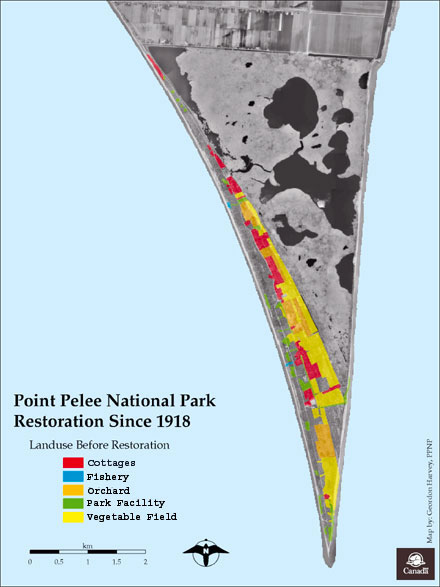page7
Granddaddy of restorations maintains remnant of Carolinian Zone
Over 70 years of perseverance restores natural environment in Point Pelee National Park of Canada
For most Canadians, the mention of Point Pelee National Park of Canada conjures up images of migrating birds and monarch butterflies, an expansive marsh, and unique flora and fauna at the southernmost tip of the country. Few people realize that Point Pelee National Park is also a "grand elder" in the national park system. With the last remaining private property in the park purchased in 2003, the most ambitious restoration project in the history of national parks is nearly complete at Point Pelee.
Founded in 1918, the original national park—or, "the Point"— totalled only 13.7 square kilometres: 2.7 square kilometres of terrestrial habitat and 11 square kilometres of marsh. The narrow peninsula of Carolinian forest and Red cedar savannah was characterized by tulip, sycamore, hackberry and sassafras trees, with Red mulberry, Kentucky coffee trees and Eastern prickly pear cactus found in the savannah. Early bird watchers and ornithologists had long recognized the Point's importance as a vital stopover on North American migration flyways. At the same time, farmers tilled the park's sandy soils, growing apples, asparagus and other crops.
Since 1933, over 50% of Point Pelee's dryland habitat has been restored. More than 100 hectares of agricultural fields and orchards have been removed, along with 6 commercial fisheries, 20 kilometres of roads and nearly 400 buildings. In the early 1970s, an exotic plant management program was established. This resource management program was designed to advance natural restoration by eliminating aggressive, invasive flora left behind by former farmers and cottagers.
Over the last 35 years, Parks Canada has increased conservation efforts by accelerating the purchase of private property within the national park and implementing a comprehensive restoration plan. Private lands and cottages were bought up and park facilities downsized throughout the 1970s. By the end of the 1980s, the national park had grown by an additional 125 hectares and large portions of the fragile shoreline were now protected. Removal of the east main park road was completed in 1998. Administrative and maintenance facilities were relocated outside the park in 2000. Visitation has stabilized at about 325,000 annually. The park's infrastructure and services continue to be assessed and "right-sized" in response to ecological integrity goals and changing visitor use patterns.
Essex County, surrounding the park, was at one time home to expansive tallgrass prairie, swamp forests and rich wetlands. Today, only 6% of the original natural environment remains. In response, the park and its greater park ecosystem partners are expanding conservation and restoration efforts with the goal of re-establishing the mix and numbers of species and ecological processes that have disappeared or been compromised. Re-establishment of green corridors and linkages to natural habitat outside the park is essential for improving the ecological integrity of the ecosystems protected within Point Pelee National Park.
In an area where the scope and complexity of ecosystem restoration can appear overwhelming, Point Pelee National Park has proven it is possible and has become a Canadian success story of what vision, hard work and perseverance in restoring and sustaining our natural environment can accomplish.
 Map of Point Pelee depicting land use before restoration © Parks Canada / H. Bishop, M. Smith, 2002; / G. Harvey, 2005 |
- Date modified :